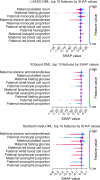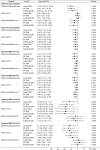Parental health at preconception and gestational age at birth: evidence from a population-based cohort using double machine learning
- PMID: 41036109
- PMCID: PMC12481323
- DOI: 10.1136/wjps-2025-001078
Parental health at preconception and gestational age at birth: evidence from a population-based cohort using double machine learning
Abstract
Background: Gestational age at birth is shaped by complex maternal and paternal factors prior to conception, yet few studies have integrated multidimensional clinical indicators from both parents to estimate their quantitative effects.
Methods: Using a large retrospective cohort with routinely collected preconception health data from both mothers and fathers, we applied a double machine learning (DML) framework combining Lasso, Random Forest and XGBoost regressors to estimate associations between parental biomarkers and gestational age at birth. Model interpretability was enhanced through Shapley Additive Explanations (SHAP) analysis, stratified interaction testing and estimation of individualized treatment effects (ITE).
Results: Elevated maternal fasting glucose, alanine aminotransferase, platelet count and anti-hepatitis B core seropositivity were consistently associated with shortened gestational age at birth across all DML models. For instance, a 10 mmol/L increase in fasting glucose corresponded to 2.8-4.9 days shorter gestation. Paternal Treponema pallidum seropositivity and increased monocyte proportion, defined as the fraction of monocytes within total circulating white blood cells, also demonstrated significant associations, with the former linked to gestational shortening and the latter to modest extension. Stratified and interaction analyses revealed that paternal immune markers modified the associations of maternal metabolic indicators with gestational age at birth. SHAP-based interpretation confirmed model consistency and ITE analysis indicated marked heterogeneity, particularly for fasting glucose.
Conclusions: This study demonstrates the utility of interpretable DML methods for quantifying the effects of multidimensional preconception health indicators from both parents on gestational age at birth. Our findings support integrating maternal and paternal screening into preconception risk assessments to enable early, targeted prevention of preterm birth. Given the established links between preterm birth and neonatal surgical conditions, early risk identification via parental screening may help inform perinatal care strategies and optimize resource allocation in pediatric surgery.
Keywords: Child Health; Health Services; Information Technology.
Copyright © Author(s) (or their employer(s)) 2025. Re-use permitted under CC BY-NC. No commercial re-use. See rights and permissions. Published by BMJ Group.
Conflict of interest statement
None declared.
Figures



References
LinkOut - more resources
Full Text Sources
